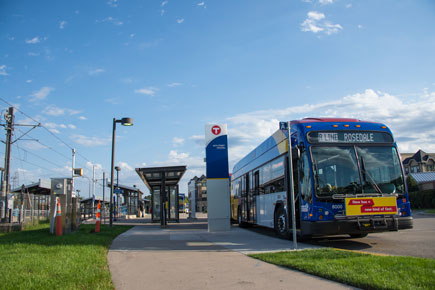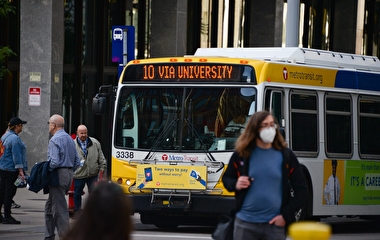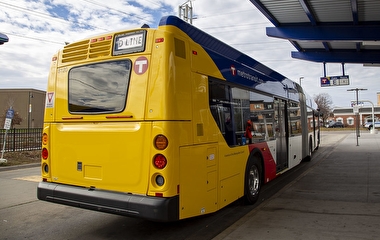Transitway service is expanding across the Minneapolis–Saint Paul metro area. In an analysis for the Metropolitan Council, U of M researchers evaluated job accessibility for five transitway scenarios. “Our results show that all five scenarios improve accessibility across the region and especially increase accessibility for workers living near transit stops,” says Kristin Carlson, a researcher with the U’s Accessibility Observatory (AO).
The project involved two main components. The first analysis compares the network as of May 2019 to the funded baseline. The funded baseline adds the C Line along Penn Avenue (which began service in June 2019), the Orange Line along I-35W to Lakeville (planned to open in late 2021), and the Green Line extension to Eden Prairie (expected in 2023).
The funded baseline increases service frequency along new and existing corridors. “On the funded network, the average worker may experience a job accessibility increase from the May 2019 baseline of 2.29 percent, averaging various travel times,” Carlson says. Transit accessibility improves on most blocks but declines where Route 19 service along Penn Avenue is reduced.
The second analysis compares the funded baseline accessibility results to those of three proposed lines: The B Line along Lake Street, the D Line along Emerson/Fremont and Chicago Avenues, and the E Line along Hennepin and France Avenues. The transitways are evaluated in isolation and in a scenario combining all three.
These lines would provide high-frequency transit service to existing transit corridors and augment local routes 5, 21, and 6. “The prospective network improves transit accessibility for the average worker by 5.51 percent, again averaging various travel times,” Carlson says. The accessibility improvements are due to the increased service frequency, speed, and directness of BRT.
However, the modifications made to local routes 5, 21, and 6 result in accessibility decreases for several groups of blocks. These areas experience a combination of reduced service frequency on local routes and longer walking distances to high-frequency routes. “The research did not account for local bus schedule coordination with the prospective transitways,” Carlson notes. “In practice, accessibility loss can be mitigated when new and existing transit services are coordinated.”
Three other scenarios isolate the relative impact of each proposed BRT line. “We found that the D Line has the greatest impact on connecting more workers with jobs in shorter travel times,” Carlson says. “The majority of accessibility benefits associated with the prospective network are from D Line service and the numerous local transit connections made in the corridor.”
The B Line appears to provide a “backbone” of transit service across the east-west axis of the urban Metropolitan Council region. Saint Paul workers gain the most accessibility benefits as a result of B Line connections and frequency.
Finally, the E Line and the changes to local Route 6 introduce accessibility gains over 100 percent in some neighborhoods while decreasing accessibility by up to 35 percent in areas that lose Route 6 service.
“The E Line corridor is an example of the ways transit network changes can manifest in accessibility impacts that change from block to block,” says Andrew Owen, AO director. “The insights from the data can inform the implementation of the E Line and the supporting transit network to best serve metro residents.”
“We know that when we add fast, frequent BRT service to these important local routes, we can shorten wait times and travel times for our riders,” says Eric Lind, manager of Research & Analytics – Strategic Initiatives for Metro Transit. “What the Accessibility Observatory analysis shows is that these improvements cascade through the bus system to improve connections in areas not immediately adjoining the transitways in question. This means there can be widespread benefit to these improvements to employees and employers across the Twin Cities.”
The research was sponsored by the Metropolitan Council as part of the National Accessibility Evaluation, a multi-year effort led by the Minnesota Department of Transportation.




